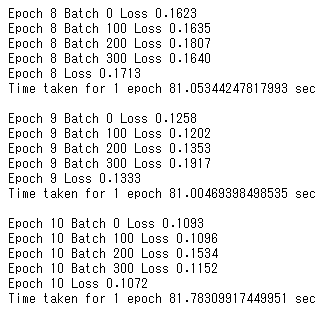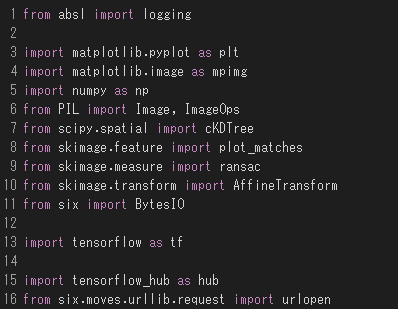seq2seqで翻訳してみた!(自然言語処理)【図解速習DeepLearning】#016
こんにちは!こーたろーです。
本日も【図解速習DEEP LEARNING】の自然言語処理を行っていきます。
今回は、seq2seq(sequence to sequence)を使って、スペイン語から英語へ翻訳してみます。
今回は、英語文とスペイン語文をペアであたえるように教師学習を行い、スペイン語文の入力を行ったときに、モデルが、対応する英語文を出力するように重みを更新していきます。
その後、未知のスペイン語文を与えて、正しい英語文を出力するかを確認していきます。
それでは早速やっていきましょう。
必要なライブラリのインポート
from __future__ import absolute_import, division, print_function from sklearn.model_selection import train_test_split import tensorflow as tf import matplotlib.pyplot as plt import unicodedata import re import numpy as np import os import time
データセットをダウンロードする
http://download.tensorflow.org/で提供されている言語データセットを用います。
こちらには、英語の文章とスペイン語の翻訳された正解の文章がペアとして蓄積されています。
path_to_zip = tf.keras.utils.get_file(
'spa-eng.zip', origin='http://download.tensorflow.org/data/spa-eng.zip',
extract=True)
path_to_file = os.path.dirname(path_to_zip)+"/spa-eng/spa.txt"

データセットの前処理
前処理の定義
前処理の手順は次のようになっています。
def unicode_to_ascii(s): return ''.join(c for c in unicodedata.normalize('NFD', s) if unicodedata.category(c) != 'Mn') def preprocess_sentence(w): w = unicode_to_ascii(w.lower().strip()) w = re.sub(r"([?.!,¿])", r" \1 ", w) w = re.sub(r'[" "]+', " ", w) w = re.sub(r"[^a-zA-Z?.!,¿]+", " ", w) w = w.rstrip().strip() w = '<start> ' + w + ' <end>' return w def create_dataset(path, num_examples): lines = open(path, encoding='UTF-8').read().strip().split('\n') word_pairs = [[preprocess_sentence(w) for w in l.split('\t')] for l in lines[:num_examples]] return word_pairs class LanguageIndex(): def __init__(self, lang): self.lang = lang self.word2idx = {} self.idx2word = {} self.vocab = set() self.create_index() def create_index(self): for phrase in self.lang: self.vocab.update(phrase.split(' ')) self.vocab = sorted(self.vocab) self.word2idx['<pad>'] = 0 for index, word in enumerate(self.vocab): self.word2idx[word] = index + 1 for word, index in self.word2idx.items(): self.idx2word[index] = word def max_length(tensor): return max(len(t) for t in tensor) def load_dataset(path, num_examples): pairs = create_dataset(path, num_examples) inp_lang = LanguageIndex(sp for en, sp in pairs) targ_lang = LanguageIndex(en for en, sp in pairs) input_tensor = [[inp_lang.word2idx[s] for s in sp.split(' ')] for en, sp in pairs] target_tensor = [[targ_lang.word2idx[s] for s in en.split(' ')] for en, sp in pairs] max_length_inp, max_length_tar = max_length(input_tensor), max_length(target_tensor) input_tensor = tf.keras.preprocessing.sequence.pad_sequences(input_tensor, maxlen=max_length_inp, padding='post') target_tensor = tf.keras.preprocessing.sequence.pad_sequences(target_tensor, maxlen=max_length_tar, padding='post') return input_tensor, target_tensor, inp_lang, targ_lang, max_length_inp, max_length_tar
使用データセットの制限による実行時間短縮
num_examples = 30000 input_tensor, target_tensor, inp_lang, targ_lang, max_length_inp, max_length_targ = load_dataset(path_to_file, num_examples) input_tensor_train, input_tensor_val, target_tensor_train, target_tensor_val = train_test_split(input_tensor, target_tensor, test_size=0.2) len(input_tensor_train), len(target_tensor_train), len(input_tensor_val), len(target_tensor_val)

tf.dataデータセットの作成
BUFFER_SIZE = len(input_tensor_train) BATCH_SIZE = 64 N_BATCH = BUFFER_SIZE//BATCH_SIZE embedding_dim = 256 units = 1024 vocab_inp_size = len(inp_lang.word2idx) vocab_tar_size = len(targ_lang.word2idx) dataset = tf.data.Dataset.from_tensor_slices((input_tensor_train, target_tensor_train)).shuffle(BUFFER_SIZE) dataset = dataset.batch(BATCH_SIZE, drop_remainder=True)
モデルを作成
GRUを定義
def gru(units): if tf.test.is_gpu_available(): return tf.compat.v1.keras.layers.CuDNNGRU(units, return_sequences=True, return_state=True, recurrent_initializer='glorot_uniform') else: return tf.compat.v1.keras.layers.GRU(units, return_sequences=True, return_state=True, recurrent_activation='sigmoid', recurrent_initializer='glorot_uniform')
エンコーダを定義
class Encoder(tf.keras.Model): def __init__(self, vocab_size, embedding_dim, enc_units, batch_sz): super(Encoder, self).__init__() self.batch_sz = batch_sz self.enc_units = enc_units self.embedding = tf.keras.layers.Embedding(vocab_size, embedding_dim) self.gru = gru(self.enc_units) def call(self, x, hidden): x = self.embedding(x) output, state = self.gru(x, initial_state = hidden) return output, state def initialize_hidden_state(self): return tf.zeros((self.batch_sz, self.enc_units))
デコーダを定義
class Decoder(tf.keras.Model): def __init__(self, vocab_size, embedding_dim, dec_units, batch_sz): super(Decoder, self).__init__() self.batch_sz = batch_sz self.dec_units = dec_units self.embedding = tf.keras.layers.Embedding(vocab_size, embedding_dim) self.gru = gru(self.dec_units) self.fc = tf.keras.layers.Dense(vocab_size) self.W1 = tf.keras.layers.Dense(self.dec_units) self.W2 = tf.keras.layers.Dense(self.dec_units) self.V = tf.keras.layers.Dense(1) def call(self, x, hidden, enc_output): hidden_with_time_axis = tf.expand_dims(hidden, 1) score = self.V(tf.nn.tanh(self.W1(enc_output) + self.W2(hidden_with_time_axis))) attention_weights = tf.nn.softmax(score, axis=1) context_vector = attention_weights * enc_output context_vector = tf.reduce_sum(context_vector, axis=1) x = self.embedding(x) x = tf.concat([tf.expand_dims(context_vector, 1), x], axis=-1) output, state = self.gru(x) output = tf.reshape(output, (-1, output.shape[2])) x = self.fc(output) return x, state, attention_weights def initialize_hidden_state(self): return tf.zeros((self.batch_sz, self.dec_units))
エンコーダ・デコーダ作成
encoder = Encoder(vocab_inp_size, embedding_dim, units, BATCH_SIZE) decoder = Decoder(vocab_tar_size, embedding_dim, units, BATCH_SIZE)
オプティマイザーと損失関数を定義
optimizer = tf.compat.v1.train.AdamOptimizer() def loss_function(real, pred): mask = 1 - np.equal(real, 0) loss_ = tf.nn.sparse_softmax_cross_entropy_with_logits(labels=real, logits=pred) * mask return tf.reduce_mean(loss_)
チェックポイントを定義し、学習途中の状態を保存できるようにする
checkpoint_dir = './training_checkpoints' checkpoint_prefix = os.path.join(checkpoint_dir, "ckpt") checkpoint = tf.train.Checkpoint(optimizer=optimizer, encoder=encoder, decoder=decoder)
モデルの学習
モデルの学習は、次のステップによって行われます。
- 入力データをエンコードして、その出力とエンコーダの隠れ状態を返す
- エンコーダ出力、エンコーダ隠れ状態、及びデコーダ入力(開始トークン)がデコーダに渡される
- デコーダは、予測とデコーダの隠れ状態を返す
- デコーダの隠れ状態がモデルに適応され、予測の損失計算が行われる
- デコーダへの次の入力を決定するために、教師強制(teacher forcing)を用いる
- 勾配を計算し、オプティマイザーを適用して、逆伝播を行う。
※なお、教師強制は、目的語がデコーダへの次の入力として渡される手法のことです。
EPOCHS = 10 for epoch in range(EPOCHS): start = time.time() hidden = encoder.initialize_hidden_state() total_loss = 0 for (batch, (inp, targ)) in enumerate(dataset): loss = 0 with tf.GradientTape() as tape: enc_output, enc_hidden = encoder(inp, hidden) dec_hidden = enc_hidden dec_input = tf.expand_dims([targ_lang.word2idx['<start>']] * BATCH_SIZE, 1) for t in range(1, targ.shape[1]): predictions, dec_hidden, _ = decoder(dec_input, dec_hidden, enc_output) loss += loss_function(targ[:, t], predictions) dec_input = tf.expand_dims(targ[:, t], 1) batch_loss = (loss / int(targ.shape[1])) total_loss += batch_loss variables = encoder.variables + decoder.variables gradients = tape.gradient(loss, variables) optimizer.apply_gradients(zip(gradients, variables)) if batch % 100 == 0: print('Epoch {} Batch {} Loss {:.4f}'.format(epoch + 1, batch, batch_loss.numpy())) if (epoch + 1) % 2 == 0: checkpoint.save(file_prefix = checkpoint_prefix) print('Epoch {} Loss {:.4f}'.format(epoch + 1, total_loss / N_BATCH)) print('Time taken for 1 epoch {} sec\n'.format(time.time() - start))


モデルを評価
翻訳用の関数を定義する
評価関数については、学習ループとにた構成となっています。
各時間ステップでのデコーダ入力は、隠れ状態及びエンコーダ出力とその前の予測のモデルが、終了トークンを予測したら予測を停止するようにします。
その後、時間ステップ単位で、attentionの重みを保存していきます。
def evaluate(sentence, encoder, decoder, inp_lang, targ_lang, max_length_inp, max_length_targ): attention_plot = np.zeros((max_length_targ, max_length_inp)) sentence = preprocess_sentence(sentence) inputs = [inp_lang.word2idx[i] for i in sentence.split(' ')] inputs = tf.compat.v1.keras.preprocessing.sequence.pad_sequences([inputs], maxlen=max_length_inp, padding='post') inputs = tf.convert_to_tensor(inputs) result = '' hidden = [tf.zeros((1, units))] enc_out, enc_hidden = encoder(inputs, hidden) dec_hidden = enc_hidden dec_input = tf.expand_dims([targ_lang.word2idx['<start>']], 0) for t in range(max_length_targ): predictions, dec_hidden, attention_weights = decoder(dec_input, dec_hidden, enc_out) attention_weights = tf.reshape(attention_weights, (-1, )) attention_plot[t] = attention_weights.numpy() predicted_id = tf.argmax(predictions[0]).numpy() result += targ_lang.idx2word[predicted_id] + ' ' if targ_lang.idx2word[predicted_id] == '<end>': return result, sentence, attention_plot dec_input = tf.expand_dims([predicted_id], 0) return result, sentence, attention_plot def plot_attention(attention, sentence, predicted_sentence): fig = plt.figure(figsize=(10,10)) ax = fig.add_subplot(1, 1, 1) ax.matshow(attention, cmap='viridis') fontdict = {'fontsize': 14} ax.set_xticklabels([''] + sentence, fontdict=fontdict, rotation=90) ax.set_yticklabels([''] + predicted_sentence, fontdict=fontdict) plt.show() def translate(sentence, encoder, decoder, inp_lang, targ_lang, max_length_inp, max_length_targ): result, sentence, attention_plot = evaluate(sentence, encoder, decoder, inp_lang, targ_lang, max_length_inp, max_length_targ) print('Input: {}'.format(sentence)) print('Predicted translation: {}'.format(result)) attention_plot = attention_plot[:len(result.split(' ')), :len(sentence.split(' '))] plot_attention(attention_plot, sentence.split(' '), result.split(' '))
チェックポイントデータの呼び出し
checkpoint.restore(tf.train.latest_checkpoint(checkpoint_dir))

翻訳し、モデルを確認
【実験その1】
入力:hace mucho frio aqui.
Google翻訳:It's really cold here.
日本語:ここは本当に寒いです。
translate(u'hace mucho frio aqui.', encoder, decoder, inp_lang, targ_lang, max_length_inp, max_length_targ)

【実験その2】
入力:esta es mi vida
Google翻訳:this is my life
日本語:これが私の人生です。
translate(u'esta es mi vida.', encoder, decoder, inp_lang, targ_lang, max_length_inp, max_length_targ)

【実験その3】
入力:todavia estan en casa?
Google翻訳:are you still at home?
日本語:あなたはまだ家にいますか?

translate(u'todavia estan en casa?', encoder, decoder, inp_lang, targ_lang, max_length_inp, max_length_targ)
【実験その4】
入力:trata de averiguarlo
Google翻訳:try to find out
日本語:調べてみてください。
translate(u'trata de averiguarlo.', encoder, decoder, inp_lang, targ_lang, max_length_inp, max_length_targ)

さて、いかがだったでしょうか。
先日の赤ちゃん言葉よりもかなり精度が高いですし、ほぼ正解ですね。
seq2seqの威力すごいですね!
ではでは。